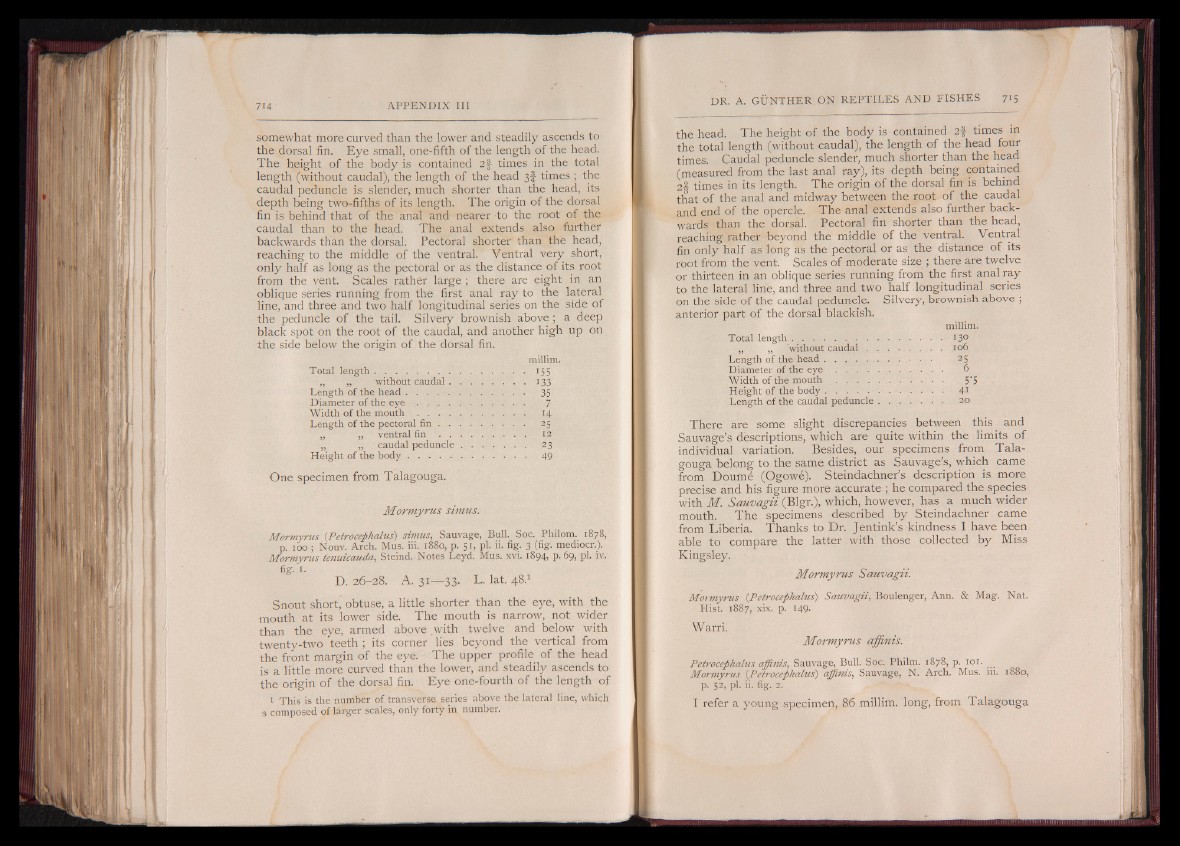
somewhat more curved than the lower and steadily ascends to
the dorsal fin. Eye small, one-fifth of the length of the head.
The height of the body is contained 2f times in the total
length (without caudal), the length of the head 3I times ; the
caudal peduncle is slender, much shorter than the head, its
depth being two-fifths of its length. The origin of the dorsal
fin is behind that of the anal and nearer to the root of the
caudal than to the head. The anal extends also further
backwards than the dorsal. Pectoral shorter than the head,
reaching to the middle of the ventral. Ventral very short,
only half as long as the pectoral or as the distance of its root
from the vent. Scales rather large ; there are eight in an
oblique series running from the first anal ray to the lateral
line, and three and two half longitudinal series on the side of
the peduncle of the tail. Silvery brownish above; a deep
black spot on the root of the caudal, and another high up on
the side below the origin of the dorsal fin.
millim.
Total length.................................................... . 155
„ „ without caudal . . . . . . . . . 133
Length of the h e a d ........................................... 35
Diameter of the e y e ........................ 7
Width of the mouth ............................... 14
Length of the pectoral f i n ................................. 25
„ ventral fin . .......................... 12
„ „ caudal peduncle......................... 23
Height of the b o d y .................... 49
One specimen from Talagouga.
Mormyrus simus.
Mormyrus (Petrocephalus) simus, Sauvage, Bull. Soc. Philom. 1878,
p. 100 ; Nouv. Arch. Mus. iii. 1880, p. 51, pi. ii. fig. 3 (fig. mediocr.).
Mormyrus tenuicauda, Steind.. Notes Leyd. Mus. xvi. 1894, p. 69, pi. iv .
fig. 1.
D. 26-28. A. 31— 33. L. lat. 48.1
Snout short, obtuse, a little shorter than the eye, with the
mouth at its lower side. The mouth is narrow, not wider
than the eye, armed above with twelve and below with
twenty-two teeth ; its corner lies beyond the vertical from
the front margin of the eye. The upper profile of the head
is a little more curved than the lower, and steadily ascends to
the origin of the dorsal fin. Eye one-fourth of the length of
1 -phis is the number of transverse series above the lateral line, which
I composed of larger scales, only forty in number.
the head. The height of the body is • contained 2 f times in
the total length (without caudal), the length of the head four
times. Caudal peduncle slender, much shorter than the head
(measured from the last anal ray), its depth being contained
2§ times in its length. The origin of the dorsal fin is behind
that of the anal and midway between the root of the caudal
and end of the opercle. The anal extends also further backwards
than the dorsal. Pectoral fin shorter than the head,
reaching rather beyond the middle of the ventral. Ventral
fin only half as long as the pectoral or as the distance of its
root from the vent. Scales of moderate size ; there are twelve
or thirteen in an oblique series running from the first anal ray
to the lateral line, and three and two half .longitudinal series
on the side of the caudal peduncle. Silvery, brownish above ;
anterior part of the dorsal blackish.
millim.
Total length.............................................................13°
„ „ without c a u d a l................................ 106
Length of the h e a d ................................ 25
Diameter of the eye 6
Width of the m o u t h ........................................ 5'5
Height of the b o d y ............................ 41
Length of the caudal peduncle . ................ 20
There are some slight discrepancies between this and
Sauvage’s descriptions, which are quite within the limits of
individual variation. Besides, our specimens from Talagouga
belong to the same district as Sauvage’s, which came
from Doume (Ogowe). Steindachner’s description is more
precise and his figure more accurate ; he compared the species
with M. Sauvagii (Blgr.), which, however, has a much wider
mouth. The specimens described by Steindachner came
from Liberia. Thanks to Dr. Jentink’s kindness I have been
able to compare the latter with those collected by Miss
Kingsley.
Mormyrus Sauvagii.
Mormyrus (Petrocephalus) Sauvagii, Boulenger, Ann. & Mag. Nat.
Hist. 1887, xix. p. 149.
Warri.
Mormyrus affinis.
Peirocephalus affinis, Sauvage, Bull. Soc. Philm. 1878, p. 101.
Mormyrus (Petrocephalus) affinis, Sauvage, N. Arch. Mus. iii. 1880,
p. 52, pi. ii. fig. 2.
Prefer a young specimen, 86 millim. long, from Talagouga